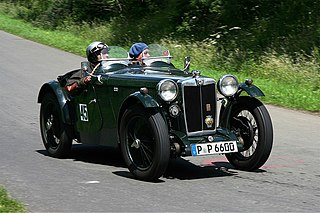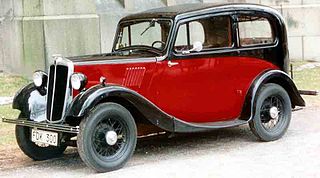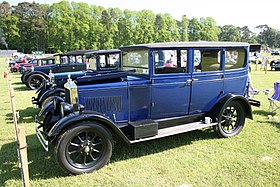
Morris Oxford is a series of motor car models produced by Morris of the United Kingdom, from the 1913 'bullnose' Oxford to the Farina Oxfords V and VI.
The Morris Isis name was first briefly used by Morris Motors Limited on a 6-cylinder car made from 1929 until 1931. It was resurrected on a new 6-cylinder midsize car from the British Motor Corporation in the 1950s to replace the Morris Six MS.

The Swift Motor Company made Swift Cars in Coventry, England from 1900 until 1931. It grew progressively from James Starley's Coventry Sewing Machine Company, via bicycle and motorised cycle manufacture. The cars ranged from a single-cylinder car in 1900 using an MMC engine, through a Swift-engined twin-cylinder 7-horsepower light car in 1904, and a 3-litre model in 1913. After the First World War a successful range was sold during the 1920s, but the Cadet of 1930 was its last vehicle as it could not compete economically with volume manufacturers such as Ford and Morris Motors.

The MG P-type is a sports car that was produced by MG from 1934 to 1936. This 2-door sports car used an updated version of the Wolseley Motors-designed and made overhead camshaft, crossflow engine, used in the 1928 Morris Minor and previously fitted in the J-type Midget of 1932 to 1934, driving the rear wheels through a four-speed non-synchromesh gearbox. The chassis was a strengthened and slightly longer version of that used in the J-type with suspension by half-elliptic springs all round with rigid front and rear axles. Steering was initially by a Marles Weller and later a Bishop Cam system. The two-seat car had a wheelbase of 87 inches (2210 mm) and a track of 42 in (1,100 mm). Most cars were open two-seaters, but streamlined Airline coupé bodies were also made. The P-type was also available as a four-seater, a car that suffered from a lack of power and poor rear ground clearance. Whereas J, K and L-type MGs differentiated between versions with the use of numbers, with 1 indicating a four-seater and 2 a two-seater, this was not the case with the P-type, and there is no clue to the type in the name.
Morris Cowley was a name given to various cars produced by Morris from 1915 to 1958.

The Morris Eight is a small family car produced by Morris Motors from 1935 to 1948. It was inspired by the sales popularity of the Ford Model Y, styling of which the Eight closely followed. The success of the car enabled Morris to regain its position as Britain's largest motor manufacturer.

The Triumph Dolomite is a car that was produced by Triumph Motor Company from 1934 to 1940. It first appeared in 1934 as a sports car and the name was also used from 1937 on a series of sporting saloons and open cars until 1939 when the company went into receivership. A number were still sold and registered in 1940, though it is uncertain whether the receiver or new owner turned out cars from spare parts, or sold off completed cars. All except the Straight 8 featured a "waterfall" grille styled by Walter Belgrove, versions of the saloons with conventional grilles were sold as Continental models.

The Rover 10 was a small family car from the British Rover car company produced between 1927 and 1947.

The MG 14/28 Super Sports is a sports car that was launched in 1924. It was the second line of cars produced by W R Morris's MG company. The first line of cars were 1548cc Morris Oxfords fitted with a two-seater body supplied by Charles Raworth & Sons of Oxford. They were built at first in small premises in Alfred Lane, Oxford moving in 1925 to a larger site shared with Morris Motors Limited radiator factory at Bainton Road, Oxford. The badge on the front of the car still read Morris Oxford, MG badges were not to appear on the car's nose until 1928 but they did appear below the Morris badge on the honeycomb of the last of the 14-28 cars which had flat nose radiators.

The MG 14/40 or MG 14/40 Mark IV is a sports car that was made by MG and launched in 1927. It was based on the contemporary Morris Oxford flatnose and was a development of the MG 14/28 and was built at Edmund Road, Cowley, Oxford where MG had moved in September 1927. During production it became the first model to carry an MG Octagon badge on its radiator, the previous cars had retained a Morris Oxford badge.

The Morris Ten is a medium-sized car introduced for 1933 as the company's offering in the important 10 hp sector of the British market. It continued through a series of variants until October 1948 when along with Morris's Twelve and Fourteen it was replaced by the 13.5 hp Morris Oxford MO.

The Hillman Fourteen is a medium-sized 4-cylinder car announced by Hillman's managing director Spencer Wilks, a son-in-law of William Hillman, at the end of September 1925. This new Fourteen substantially increased Hillman's market share and remained on sale into 1931. During this time it was the main product of the company.

The Rover 12 was a name given to several medium-sized family cars from the British Rover car company between 1905 and 1948.
The Palmerston was a British car made by the Palmerston Motor Company based in Bournemouth, England between 1920 and 1923.

Morris Twelve is a model of Morris car introduced without fanfare in the autumn of 1934 as little more than a larger engined Morris Ten Four for which just another £5 was asked. The chassis and body were of the slow-selling longer wheelbase Ten Six. The engine though awarded a tax rating of 11.98 hp had a cubic capacity of 1548cc compared with Morris's 1292cc (10 hp) Ten Four and 1378cc (12.09 hp) Ten Six.

Morris Oxford is a series of motor car models produced by Morris Motors of the United Kingdom, from the 1913 bullnose Oxford to the Farina Oxfords V and VI. The manufacture of Morris's Oxford cars, named by W R Morris after the university town in which he grew up, would turn Oxford into an industrial city.

Morris Oxford is a series of motor car models produced by Morris Motors of the United Kingdom, from the 1913 bullnose Oxford to the Farina Oxfords V and VI.
Morris Oxford is a series of motor car models produced by Morris Motors of the United Kingdom, from the 1913 bullnose Oxford to the Farina Oxfords V and VI.

The Morris Oxford Six is a motor car produced by Morris of the United Kingdom from 1921 until 1926, and again from 1929 until 1935. Initially produced as a straight-six engined version of the Morris Oxford bullnose, the original Oxford Six was the first car produced by Morris with a six-cylinder engine, but proved to be unreliable. The versions produced from 1929 onwards were introduced as a replacement for the Morris Oxford 16/40.

The "bullnose" Morris Oxford is a series of motor car models produced by British manufacturer Morris from 1913 to 1926. It was named by W R Morris after the city in which he grew up and which his cars were to industrialise.


















